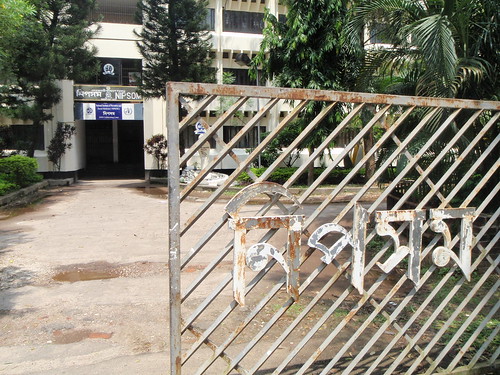I have made an interesting contact here in Bangladesh. Dr. Kazi Bennoor is an MBBS (Bachelor of medicine and surgery) physician and assistant professor of respiratory medicine at the “National Institute of Diseases of the Chest and Hospital“, in Dhaka. I contacted him initially back in June while performing a Google search on the “American Thoracic Society (ATS) questionnaire in Bangla”. Since I had been planning on using it as a large component of my questionnaire for the shipbreakers, I wanted to see if somebody had already used it in another Bangladesh based study. He told me he had used a version of this questionnaire in a published study on asthma prevalence in Bangladesh, and another study in the works on prevalence of Chronic Obstructive Pulmonary Disease (COPD). I hadn’t considered contacting him again until recently; Zakia and I have been pilot testing the questionnaire on local rickshaw pullers and construction workers, and a few questions/concerns have arisen. I remembered Dr. Bennoor, contacted him, and met with him the same day. The hospital started off as a tuberculosis (TB) sanitarium in 1955, and therefore is known to locals as the “TB hospital”. Today it is the only tertiary care hospital in Bangladesh for chest diseases. It offers an MD degree in chest diseases and an MS degree in thoracic surgery; it is affiliated with University of Dhaka.
Dr. Bennoor looked briefly at the Bangla version of my questionnaire and said that yes, it was almost exactly translated they way theirs had been. They used their ATS questionnaire for two studies so far. One on asthma that was published in the International Journal of Epidemiology in 2002 entitled, “Self reported asthma symptoms in children and adults of Bangladesh: Findings of the national asthma prevalence study”. In this study 5642 people were interviewed, and the questionnaire had been pilot tested in 10 districts (of 64) in Bangladesh as all regions have slightly different dialects, including two districts next to Bogra. The second study it was used for, was a COPD study that has not yet been published, but over 3000 people have been interviewed with it. He said they made slight adjustments to the ATS questionnaire; for example, one question asks if the subject can unbutton and button his shirt without feeling breathless, but in Bangladesh most people don’t have button up shirts, so instead they asked, “Can you perform Ozu, or the washing up before prayer time, without feeling breathless?” He has offered to look over the Bangla and English questionnaire over the Eid holidays (next week) to let me know if he has any suggestions for areas I could alter.
He was very interested in “B Readers” as he was not familiar with them and is keen to learn more. A B Reader is a specialized radiologist who demonstrates proficiency in the classification of chest radiographs for the pneumoconioses using the International Labour Office (ILO) Classification System. With enough clinical and work history information, along with a good quality chest x-ray (CXR), a B Reader can examine the CXR and distinguish between silicosis and asbestosis. A B Reader from the University of Washington will be examining my shipbreaker CXRs. Dr. Bennoor explained the diagnostic facilities at his hospital are not good enough to diagnose interstitial lung diseases (ILD), much less the source of it (in my case, asbestosis and asbestos, respectively). The idea of training B Readers in Bangladesh could be an exciting , feasible future project here in Bangladesh, and something the ILO could even become involved in.
Diagnosis and treatment protocols are available for:
• TB – Uses WHO guidelines (and in addition, a campaign by the National TB Program that urges people who have a chronic cough for > 2 weeks to go to a hospital)
• Pneumonia – Uses acute respiratory tract infections (ARI) guidelines
• Asthma, bronchiolitis, and COPD – Uses guidelines created by the Asthma Association of Bangladesh. I currently have a copy of their third edition from 2005
• ILD – No guidelines and in Bangladesh has not been explored. Dr. Bennoor is very interested about the magnitude of the problem here, and therefore seemed all the more interested in our study.
These available protocols, along with a better idea of what is not available, will help immensely with the “case management strategy” we are creating.
Dr. Bennoor asked why we were not performing spirometry (breath measurements) with the 100 shipbreakers in Bogra as it would only add 10 minutes onto each interview. Initially my committee had brought it up, but there was an issue of not having the equipment, not being sure of the cost, and not wanting to make the project any larger. Well, Dr. Bennoor has offered to lend us his portable one for my time in Bogra. He demonstrated to me how to use it and explained a relatively simple procedure of reading the FEV1 (forced expiratory volume in 1 second) and FVC (forced vital capacity) off the screen and taking the ratio. After discussing this with my committee however, it seems as if the procedure should be quite a bit more complicated than this and so I am not sure at this moment if we will go through with it.
I believe Dr. Bennoor will be a key contact here in Bangladesh and a meeting with him should be arranged when a couple of my committee members visit in November/December.
